Tuesday, February 16, 2010
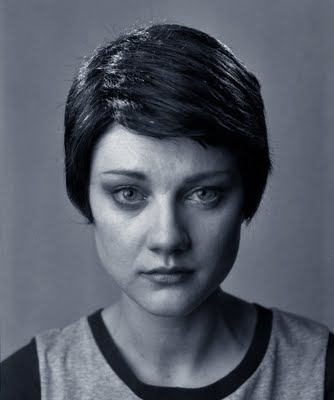 The expense of spirit in a waste of shame
The expense of spirit in a waste of shame
is lust in action; and, till action, lust
is perjured, murderous, bloody, full of blame,
Savage, extreme, rude, cruel, not to trust:
Enjoyed no sooner but despised straight;
Past reason hunted, and no sooner had
Past reason hated as a swallowed bait
On purpose laid to make the taker mad.
Sonnet 129, William Shakespeare 1609

Sometime in spring of 2001 I was approached by Richard Wolfe and Tim Carlson of Theatre Conspiracy with an offer I could not refuse. They were going to mount a performance of Patrick Marber’s play Closer (June 7-16) and they wanted me to take pictures even before the rehearsals began. Wolfe was the director and Carlson the assistant director. The idea is that our pictures (in collaboration with Argentine painter Nora Patrich) would serve as special promotional photographs, as photographs to be used in the program and the photos and collaborations with Patrich (part sketches and part photographs) would hang the night of the opening in large frames.

The actors Kurt Max Runte (as Larry, seen here in a doctor’s smock) Steve Griffith, Michelle Harrison ( Alice seen here as the stripper) and Sarah Louise Turner ( Anna as the photographer) had not really met. Patrich and I put them into a room of the Marble Arch (we had read the script) and set up the shots. We were in the room for four hours. What was really amazing for me is that I had forgotten that actors can act, particularly on demand with short notice! I would give them instructions and they would do as told. I would only need to shoot one or two frames. Runte and Harrison posed in one of the real stripper booths of the Marble Arch. It felt authentic. The amount of emotion we were able to extract from these four was an experience I will never forget.
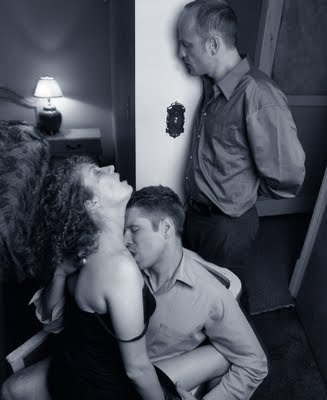
I have seen some excellent theatrical pictures in Vancouver through the years but just this time I will beat on my own drum to opine that these pictures are really special.
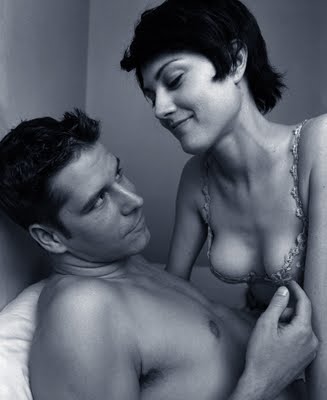
If you read the plot synopsis here you will understand the gist of the pictures and the reason for the camera, the doctor's smock, the mouse and Steve Griffith (Dan) in drag.
Anna. "She has one address in her address book; ours ... under 'H' for home."
Dan. I've cut that line.
Anna. Why ?
Dan. Too sentimental.
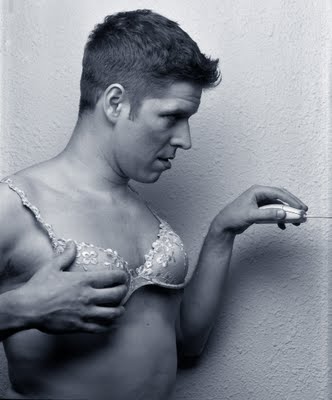 
Dan. What do you want ?
Alice. To be loved.
Dan. That simple ?
Alice. It's a big want.
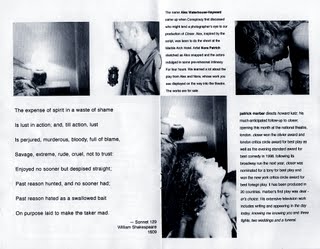 
Larry. It's about you, isn't it ?
Alice. Some of me.
Larry. Oh ? What did he leave out ?
Alice. The truth.

Pluto Platters & Wham-O Blowguns
Monday, February 15, 2010
 On February 13 I read in my hard copy NY Times: Walter Fredrick Morrison, who at 17 sent the lid of a popcorn tin skimming through the air of a California backyard and as an adult remade the lid in plastic, in the process inventing the simple, elegant flying disc known today as the Frisbee, died Tuesday at his home in Monroe, Utah. He was 90.I was not aware that Morrison’s invention before it was bought by the Wham-0 company in 1958 had been called the Flyin’ Cake Pan, the Whirlo-Way the Flyin’-Saucer and finally the Pluto Platter. I read the obituary with nostalgic interest but I must clarify that I never did master the art of throwing a Frisbee. It may have been sometime around 1959 when the Frisbee arrived to St. Ed’s High School in Austin, Texas. The master of the sailing art was my friend (and now a successful dentist in Houston) Steve Burdick who tried his best to teach me. My expertise with wrist work involved the ping pong paddle. I was one of the best in school in that game. The Frisbee was never my thing and I remember young men throwing them in Kitsilano Beach here in Vancouver in the mid 70s. They often played the game with their dogs. I found the whole exercise kind of silly! My son-in-law Bruce Stewart plays something called Frisbee Golf. While the Frisbee and I never did get along I had an early relationship with the Wham-O company in 1957 when I was a nerdish freshman at St.Ed’s. 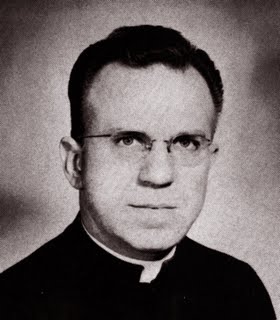 Because I was an Argentine born boy who had lived in Mexico so that my accent was a blend of Argentine and Mexican I was considered an outsider by la Raza (those that were either Mexican of Mexican heritage) while the white Texan/Americans considered me a foreigner (even though I, too was white and spoke English). I was in between and part of neither camps. I was left to my own resources. 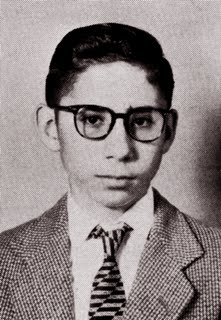 So I took advantage of the efficient American postal system and became a member of a “club” in which I purchased b+w glossies of airplanes including military fighters, vintage WWI and II plus the more recent jet fighters and bombers. The club also had a new section and I began to collect photographs of what they called guided missiles. I remember the BOMARC and the Nike. I also constructed gadgets. My source of materials for these gadgets was an army surplus store on Congress Avenue that was very close to the Congress Avenue Bridge (before the bats settled in). It was at that store that I bought a special compass that I could adapt into a flying-saucer-spotter. The compass could be opened so I was able to put two electrodes on either side of North. The electrodes I connected to a buzzer that was battery-powered. At night I would position the device under my bed with the compass pointing north. The idea behind the gadget is that many in those flying saucer sighting days had read (as had I) Major Donald Keyhoe’s The Flying Saucers Are Real and Flying Saucers From Outer Space. We were thus aware that the proximity of a flying saucer would affect the magnetic field. This meant that a nearby compass needle would fluctuate. If I had built my gadget correctly the buzzer would sound! What I was not aware until Brother Vincent De Paul, CSC punished me for waking up part of the dormitory one night was that large tractor trailers also modified the magnetic field. Brother Vincent commanded me to disconnect my compass. I shifted my interests to potentially more destructive and dangerous endeavours. I purchased a Wham-O sling shot. I remember when it arrived in a little brown package. You loaded the leather pouch with steel balls or copper BBs. I was soon practicing by the creek with glass beer bottles. 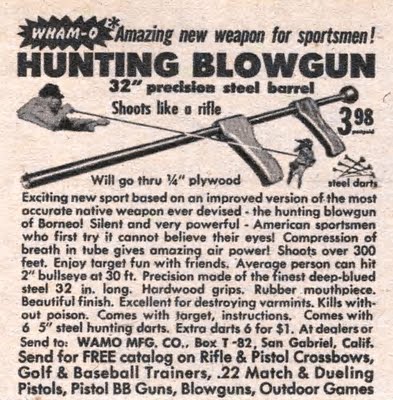 When I saw an ad for the Wham-0 blowgun I rapidly lost interest in the sling shot. It arrived in a longish box. It was partly collapsible in that you connected the rear part with the hand grips to a front part. It came with steel darts that were five inches long. The weapon was silent and I soon came to realize that it was dangerous and could be deadly. Do you think the Brothers of the Holy Cross would have taken it away from me? Absolutely not, as far as Brother Vincent was concerned my “toys” made no noise at night! For a while I practiced to see how much my darts would pierce plywood. But the weapon was useless with beer bottles. I visited the army surplus store and bought a co2 cartridge powered air pistol. I also bought a Spanish American War vintage leather holster (used for carrying a .45 caliber automatic). While many of my classmates became members of the National Rifle Association and joined the Rifle Club run by Brother Stanley Repucci I was never tempted. I perhaps did not know then but I might have already been a liberal who believed in gun control and a Canadian type of socialized health care system. I did not have the credentials to ever be a Texan. But I did practice by the creek to see if I could unholster the gun as quickly as Matt Dillon. Brother Vincent did not take away my air pistol. It was in the summer holidays before I returned to St. Ed’s for Grade 10 that I ran into my first and last incident with my toys. In Nueva Rosita, Coahuila where my mother taught school to the children of the engineers of the American Smelting and Refining Company, we lived close by to a our American bowling alley. I remember spotting the older man who ran it, Juan standing by the door. Without thinking I put a dart into my blowgun and blew. The dart penetrated the door, inches from his face. My mother took away the blow gun. I was too old for an old-fashioned paliza (whipping). Addendum: My son-in-law, Bruce Stewart has informed me that he does not play Frisbee golf. "It is called disc golf because if you were to try to catch one of these it would break your fingers."
Le Roi Est Mort, Vive Le Roi!
Sunday, February 14, 2010
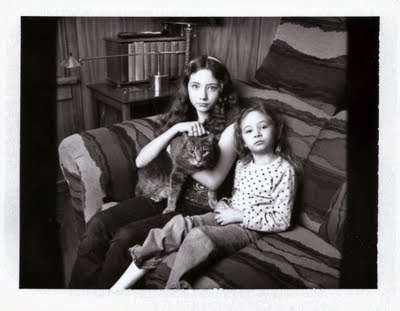 Le Roi est mort, vive le Roi! Friday was indeed a sad day. I took Toby to the SPCA. I almost felt that Toby was apologetic when he soiled his plastic cage in the car. When Dr. Peter Lekkas saw Toby and noticed how far he had deteriorated after a previous visit a couple of weeks ago he looked at me and we both agreed on the course of action. I told Dr. Lekkas that while he dealt with Toby I was going to cross to the adoption side to see if some cat would appeal to me. That being the case I was going to adopt the cat, right on the spot, take him home and present Rosemary with a fait accompli. I did find a cat but I was not able to take him home. The cat I saw was in a sterile quarantine section of the SPCA because many of their cats had suffered from respiratory diseases. They had all been kept apart just in case. In order to see the cats I had to slip into plastic booties and then stand for 30 seconds in a strong disinfectant. There was one cat I immediately noticed. He was a very large gray tabby with almost no markings, with strikingly large eyes of an unearthly yellow green. He was pleasant, low key and affectionate. His name was Kassy which was short for Kassynova [sic]. When I told the woman in charge that I was interested in Kassy she asked me, “Which cat is she?” The folks at the SPCA told me that Kassy, 6, was a one cat household cat and that he was most definitely a house cat. That he was a house cat was evident as the 18 pound cat was certainly overweight. I was further told that he had never been around children. It seemed it was all stacked against me. I told them I wanted to take the cat anyway but I was denied. There is a new regulation that stipulates that if a person wants to adopt a cat in a two-person household the other person has to be there. Dr. Peter Lekkas tried to “fix” the situation by vouching that we were cat people and that I was not married and had no wife! I went home minus the cat. Rosemary reluctantly told me that we would go the next day with the girls but she didn’t think she was ready for another cat just yet. I was thinking that as our financial fortunes diminish going from one cat (an eventually to none) might be our ticket if we plan to travel and or live in a small apartment. Both Rebecca and her mother Hilary said I should get another cat that would be Rosemary’s, as Toby had been. Rebecca was precise, “Abi thinks that Plata (my female cat) is a bitch. She wants a cat of her own.” So we went to the SPCA and all four of us crowded into the room wearing our plastic booties. Kassy sat on our lap, one at a time. He never hissed or in any way showed any inclination to be aggressive with the girls. I said nothing but Rebecca kept harping to her grandmother that this was indeed the cat that was going to be hers. We left the SPCA with our cat. Both Lauren and I decided that Kassy would go back to his original name but spelled correctly. He would be Casanova and we would call him Casa for short. He is big as a house so the name fits. During the whole two days Rosemary was so confused and worried about a possible adoption that she never really stopped to consider that I had returned Friday afternoon with Toby in a box. I opened the box in the garden to find a white towel that was wrapped almost in a ball. I could see Toby’s lovely white front paws sticking out. I had no heart to look any further. I dug the hole and put Toby in it. It began to drizzle as I covered the hole with leaves and dirt. As Rosemary said when I went up the stairs, “Toby is home.” Plata did not know what to do when we arrived on Saturday with Casa. Casa was a bit shy and would hide under the bed (as cats so expertly manage to be in the exact centre so you cannot reach them). But by today Sunday Casa knows where the litter box is. He is friendly with everybody and allows himself to be picked up (if you are able to!) without any fuss. Rosemary had Casa on her chest while lying in bed. She is not too sure about Casa. She likes the traditional tabby cats with lots of markings on the body and those lovely white paws that Toby had. Rebecca pointed out that Casa is indeed a tabby as he has an M above the eyes. I have a feeling that Rosemary and Casa, Casa and Plata, will be friends real soon. We will not forget Toby. Today Rebecca called to say she, Lauren and their Nana wanted to pay us a visit so that Nana could meet Casa. We had hot chocolate and tea. I had the opportunity to take this Fuji instant print so that you can see Casa, at home.
The Cat In The Box
Saturday, February 13, 2010
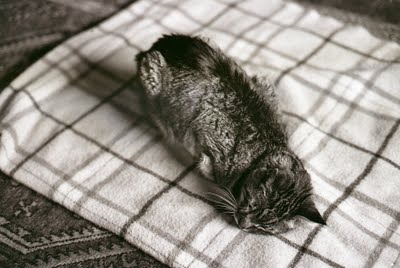 This blog will have Saturday February 13th as the date but I am writing it today Friday a little past noon. I feel I cannot do anything except anticipate with some dread my drive with Toby at 2:30. Our 19 year-old cat Toby is going on a one way trip to the SPCA today. I will bring him back in a shoe box and bury him in the garden. To the end Toby has done his best to be a clean cat. This morning he jumped from our bed and he did his business on a pile of newspapers by the bed. A couple of days before he had rolled down the stairs to reach the kitty litter box in the kitchen. That must have hurt! He has done his best. Last night he wanted to jump off the bed but Rosemary was on the phone and prevented him from doing so. The jump from the bed would have been pain. We had to wash our sheets and Toby himself was a mess. I gave him a warm shampoo bath to clean him up. He did not struggle. I do believe that Rosemary knows her cat has to go. It will be unpleasant tonight and I will not be able to comfort her. I have always maintained that the quickest cure to a dead cat is a brand new one. I am not sure that we are ready to have another cat. The new cat would have to adapt to our female Plata who is fairly high strung. As our life winds down, having pets at home always puts a pressure on having to find someone to take care of them when we travel, even when it is a two-day stay at Ale’s in Lillooet. But a new cat would help bury some of Rosemary’s grief tonight. I will have a look at the cats at the SPCA. Who knows? Will Toby be the only cat (in a box) as I return home tonight?
Ellen Bry - Olympic Pheromones
Friday, February 12, 2010
It is fascinating how the intention of a meaning can vary with a language. Take for example the Spanish term aguafiestas. It literally means a person who waters down a party. My guess it has to do with the idea of diluting the booze or unspiking the punch bowl In English the term party pooper is self-evident and I wonder if there is a continuity of connection with the American term, “as funny (or as popular) as a turd in a punch bowl”.
I don’t want to be an aguafiestas with these 2010 Olympics. Perhaps I will wake up in a few days to experience that spirit our Vancouver Sun writes about. I certainly don’t want to emulate the spirit of that man that visits Rick Cluff’s Early Edition on CBC Radio 1 on Mondays. The man in question has trivialized and cheapened Bill Vander Zalm’s famous use of the word fantastic. That indefatigably tedious man should be pushed down the Olympic ski jump at Whistler. Fantastic! I have a feeling that Cluff would help me push. But I will stop here before I am accused of ranting.
I don’t want to be an Olympic party pooper. Even I, hope that Canada, my adopted country, reaches the gold medal final for men’s hockey. Of the other sports I will pass, and I will diverge to a holding pattern around pleasant matters. One that I re-discovered by accident last night was a file called Bry, Ellen.
Knowingly I have never seen this American actress (born in 1951) in any film. I never saw a single episode of the cult TV series St Elsewhere and I have avoided any TV programs with pointy eared characters that did not feature Leonard Nimoy as Mr. Spock.
I met Bree only once in 1987 in Whistler. I had gone there with Les Wiseman to report for Vancouver Magazine the goings on of a celebrity ski-a-thon. I don’t think that Wiseman ever did write two lines on any of the 2 or 3 ski-a-thons we attended. He found ways of convincing our editor, Malcolm Parry that this was a worthy pursuit and that we should go. The real reason was that the Whistler organizers promised the presence of Brooke Shields. Wiseman had a thing for her. Shields never did show up so we nursed single malt Scotch and sodas and photographed and interviewed as many other “celebrities” we could find. At the time Wiseman had a column for TV Guide. I guess some of what he wrote found a home there. In my case the one big break was a TV Guide cover of that other St. Elsewhere star, Bruce Greenwood.
When Wiseman and I met Bree, neither of us knew who she was. Wiseman consulted with a PR man who clued him in. The cluing did not come soon enough as it seems that I went up to Bry and told her, “We are a couple of ignorant Canadians. Who are you?”
I have very little memory of what transpired after that. Wiseman says Bry invited us to a party up in the mountain yet the picture here has her in a very nice low cut dress.
What I do remember is that when she faced my camera (At the time I had the silly notion of using Hollywood lighting which made it difficult for her to move. I was also kind of new at it and had little knowledge of what I was doing.) she was with me and with nobody else. I had a sense of a woman who was spraying me with either real pheromones or she was projecting some mental version of them straight into my brain. I don’t think I have ever felt quite like that and I have photographed my fair share of women clothed and otherwise. I felt seduced and attracted to her. I had a similar experience, but not as pleasantly intense, when I photographed German actress Barbara Sukowa.
Today, instead of lingering about the Olympics I will think of Bry and again feel lucky that I am a photographer and not a plumber.
Revolutionary Cola - A Manifesto Of Soft Drinks
Thursday, February 11, 2010
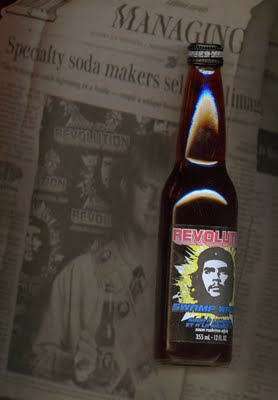
Most of my life I have considered myself a connoiseur of non alcoholic drinks. I don’t drink much of the alcoholic variety. I avoid invitations to most weddings by stipulating, “Unless you serve Moët et Chandon I will not attend.” This ploy failed me once in a most pleasant way! I attended that wedding.
As a little boy I had a fondness for chocolate milk. There was a powdered form called Toddy that sponsored my favourite radio program, Tarzán, El Rey de la Jungla. When I was 8, I forced my mother to take me to a parade in downtown Buenos Aires to see Tarzán. I remember he was sitting on the upper part of a convertible back seat and he had a banner across his wide chest (like the ones worn by Miss Universe) that read Tome Toddy (Drink Toddy).
I have a vivid memory when I was 9 of getting of the train in Belgrano with my mother to walk to school. She taught at the American High School and I walked two blocks more to the American Grammar School. On the way there was a little quiosco (a small covered stand) that sold soft drinks and blender juices. My favourite was banana con agua (water and banana, and the banana had to be slightly green)). On that particular day there was a little sign that read “ Nueva y refrescante bebida, Seven-Up”. I insisted and my mother had to buy me my first ever Seven-Up and it was not quite 8:30 in the morning.
Most of us who recognized the real thing would have never tried that inferior Argentine cola drink called Bidú. Sipping one of those was as embarrassing as wearing jeans that were not Lees.
Once in Mexico in the mid 50s my favourite soft drink was the no-gas Delaware Punch (pronounced delláwhere ponch, if you wanted the grocery guy to know what you were asking for). I had the strange habit of drinking 3 or 4 of them (one right after the other) using a macaroni as a straw while watching Boston Blackie on our Zenith TV.
In the early 50s some Mexican politician noticed on a routine trip into the country's interior that there seemed to be lots of very young children walking tipsy in the small towns. He investigated and was told that these towns rarely had good, clean running water so the children drank mild pulque (an un-distilled version of tequila) as this was deemed safer.
The politician reported to the President of Mexico and immediately plans were made to develop a softdrink and beer industry in the country. These businesses would be given tax incentives and government help. By the late 50s there was a dizzying variety of interesting Mexican soft drinks (alas Delaware Punch disappeared) and there was more than coca, orange and pecsi (as real Mexicans pronounced Pepsi). It was in these times that the Mexican beer industry came from nothing to become a one of the leaders which such innovations like bottled beer on tap and early versions of the twist cap. There were some small, tubby uncarbonated drinks called Chaparritas El Naranjo. They came in several flavours but my favourite was mandarina. Chaparrita means short and small in Mexican Spanish. A Spaniard, a Mr. Mundet revolutionized the soft drink industry with a pasteurized apple drink called Sidral Mundet. And then there were the Jarritos. Most of us really liked the tamarind flavour one. As a hip teenager I avoided the very Mexican (it was terrible) Mexicola as much as I had avoided that Bidú in Buenos Aires. Mexicola was hyped by Mexican bantamwheight champion Raúl (Ratón) Macías. My mother really liked Squirt and when I married Rosemary in 1968 she insisted on drinking Squirt, too. One thing we do avoid here in Vancouver, besides now drinking few soft drinks with the exception of ginger ale, is to place a large soft drink bottle on the dinner table. Mexican Coca Cola manufactured a very large glass bottle called a caguama. Caguama is Mexican Spanish for a very large turtle.
My Yorkshire-born friend, Andrew Taylor lived nearby our Arboledas home in Mexico City. He was a student so he still lived with his parents in the fashionable gated community called Fraccionamiento La Hacienda. His father Colin, was the comptroller for Coca Cola in Mexico. I loved going to visit Andrew because through his father’s connections they were able to serve Twinnings English Breakfast Tea which was much more palatable that my often reused Lipton Tea bags (when I could get them). On one occasion we were invited for dinner. Mrs Taylor was an excellent cook and Colin sat proudly at the head of the table and served us. I chose that precise moment to tell him that Coca Cola was high in phosphoric acid and that many in the automobile industry used his product to remove rust from chrome bumpers. He was not amused
Rosemary and I both agree that our favourite carbonated water is San Pellegrino. We find it slightly more acidic (better!) than Perrier. Every once in a while I surprise her with a Squirt. Hilary is trying to get off her Coca Cola-in-a-can addiction by drinking only one per day. Rebecca loves Dr. Pepper. I still drink my banana blended with lots of ice and water. And yes that banana has to be green.
On September 1998 the Globe & Mail dispatched me to Langley to photograph Robert Kyle, the president of Bev-Source a beverage company. They had just launched a family of 6 drinks called Revolution with Che Guevara on the beautifully painted label. The promotion included T-shirts (I have two of them) and stickums. I have kept three bottles of my original 6 variety. They are as follows:
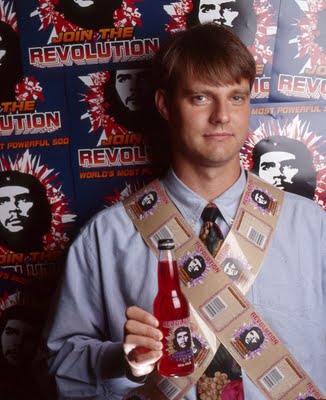
Sarsaparilla – Rootbeer with attitude
Brainwash Cola – High caffeine cola
Swamp Water – Soda Fountain Blend
While I don’t remember what the other three were I think one of them was a cream soda that had the name Rebel Red. They were good.
If I would tell any of you readers of this blog about the former existence of Revolution Cola, you would probably not believe me. But the pictures here are the proof.
Today Rosemary insisted on my going through my photo files from A to D. I was to read her names of people I might want to send my promotional postcards so that we can do a Lazarus on my photography business. It was during that search that I found the file Che Guevara Cola. There was another for which there is no room today. The file read Catch-It (Kitty Litter). Now I was dispatched by….
Gol olímpico & Pissing Against The Wall
Wednesday, February 10, 2010
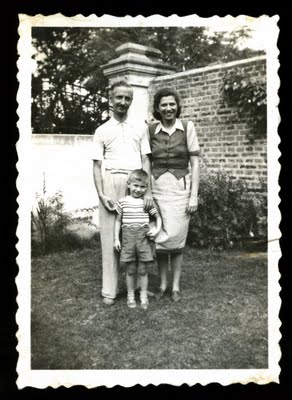
Since I can remember I was not good at sports. In Buenos Aires I was a so-so player in our gym classes. Since this was Argentina I had no knowledge of baseball or something called American football. We played futbol, the English brand, cricket and rugby. I was much too small and thin for rugby so I gave it up. My neurons could never rise up to the challenge of understanding the rules of cricket. This left me with futbol, a sport I never mastered as my two left feet prevented me from ever excelling at it or in that other Argentine endeavour, the tango.
My failure in futbol did not prevent me from playing the favourite street game of the time (I was 8 and 9) called estampitas. You would buy at the corner grocery store these futbol estampitas which were the size, shape and heft of the cardboard stoppers of the milk bottles of the time. Here in North America they would have been called trading cards. Estampitas had portraits of the players of the Argentine futbol league. On purpose, the makers of the estampitas issued fewer portraits of the stars. We traded. We traded as we could also buy a comic book sized publication on which we could stick the pictures. The goal was to have all the blank circles in the pages full. We traded but more often we played a came which consisted in tossing (very carefully) the estampitas against a wall from a few metres away. The deal was to get your estampita as close to the line between the wall and the sidewalk. If you got it that close you won all the other estampitas thrown by your friends. I had two left feet but a very good right hand.
Because I was half English, raised as a snob by my parents (in picture here taken in January 1948 when I was 5) to snub at anything that was popular with the masses I was never taken to a futbol game by my father. My father looked down on our neighbours who would loudly play the speeches by Perón and Eva Perón during the festivities of 25 de mayo and 9 de Julio. He also looked down and considered it awfully gauche when they would listen to such Argentine classic futbol games as the one between Boca Juniors and River Plate (Club Atlético River Plate). As soon as there was the goal the announcer would prolong the goal into something like, “¡Goooooooooooooooooool, gol de Boca Juniors…!"
When possible, and on the sly, I did listen to some games. I was struck by some of the expressions the Argentine announcers used. These were hans (for touching the ball with your hands which was an infraction), or penalty. I also often heard corner for the corner kick. In those days they infrequently used the acceptable term in Spanish which was mano and penal. The latter was a penalty shot to goal. Expressions such as backs and senteroforaward were often used.
I smiled at the concept of the name of one the worse teams in the league called Newell’s Old Boys founded in 1903 in the city of Rosario and still around today. They are the Argentine answer to the Cleveland Indians.
It was my Jewish/German friend Mario Hertzberg, who lived across the street, who would clue me in as to who the best teams were and who were the stars. One day he told me about el gol olímpico. This was a goal which was a corner kick (called a corner even in Spanish until in more recent times it was re-named tiro de esquina). The ball would somehow curve into the goal (or bounce in) without any other player touching the ball.
Which was the first one? Fifteen minutes into an international game between the Argentine National Team and the Uruguyan played on October 2, 1924, Argentine forward Cesáreo Onzari kicked the ball from his corner position and it produced a goal. The Argentine team won the game 2-1. They called it a gol olímpico to make fun of the fact that the Uruguayans were recent Olympic winners (Paris) in futbol.
There were other players who had done this before but until the IFAB (International Football Association Board meeting of 15 June 1924) authorized it for the following season such goals were disallowed. While Onzari is considered the first for the feat because his teammates called it a gol olímpico the very first gol olímpico occurred in Scotland on August 21 and it was kicked by Billy Alston.
The gol olímpico remains a rare occurrence, often accomplished by fluke rather than intent, and with the goalkeeper usually blamed for an error. The only Olympic goal in the World Cup finals was scored for Colombia by Marcos Coll, beating legendary goalkeeper Lev Yashin in a 4–4 draw with the Soviet Union in 1962.
One of the few perks of being a conscript in the Argentine navy is that in uniform I could attend any futbol game for free. In that uniform I saw a clásico between Boca (Boca Juniors) and River (River Plate). I arrived late. I remember being in a colectivo (bus) on my way to the game played in the Buenos Aires barrio called La Boca. I could hear a loud roar from the inside of the bus. When the bus stopped at the stadium and I got off I was able to understand what the roar was. Half of the stadium (30,000?) was shouting in unison an insult to the referee. They were shouting "¡hijo de puta, hijo de puta!"(son of a whore!). Once in the stadium I had to stand where those with the cheap tickets stood. This was far from the upper stands called the plateas. One of the singular pleasures of going to football match was to drink a chocolate milk concoction called a Vascolet. Those in the upper areas opted for beer in paper cups. Bottles had been banned years before for obvious reasons. I was not prepared to what followed. The fans in those upper reaches would piss in the empty cups and then throw them down to where we were. I had to jump out of the way many times.
Another time I went to a game between River and Santos of Brazil. At the time (1965) Pelé still wore the dazzling white uniform of that team. I watched him make a goal which for me surpasses any gol olímpico. On his way to the Argentine goal he was met up by two River defenders. He kicked the ball with his heel so that it arched up into the air and in front of him. He ran past the two defenders to receive the ball which he kicked into the goal before it even hit the ground. There were shouts of of !Off side!" The goal was allowed. I was thrilled. As I went down the concrete platform of the River Plate stadium I noticed that the floor was very wet. I then noted that hundreds of men were pissing against the wall and the urine was simply following the dictates of gravity.
I have no doubt that when I read about Scottish or English soccer rowdies (hooligans!) trashing trains after a football match, that Argentines inherited not only a love for the game but also the ancillary rules of misbehaviour of the Sceptered Isle.
A note on rules of Spanish Grammar. In Spanish, nationalities, argentino, dates, julio are never capitalized. Thus a goal, an Olympic goal would still be gol olímpico no matter what the IOC or VANOC might opine and dictate.
|




























